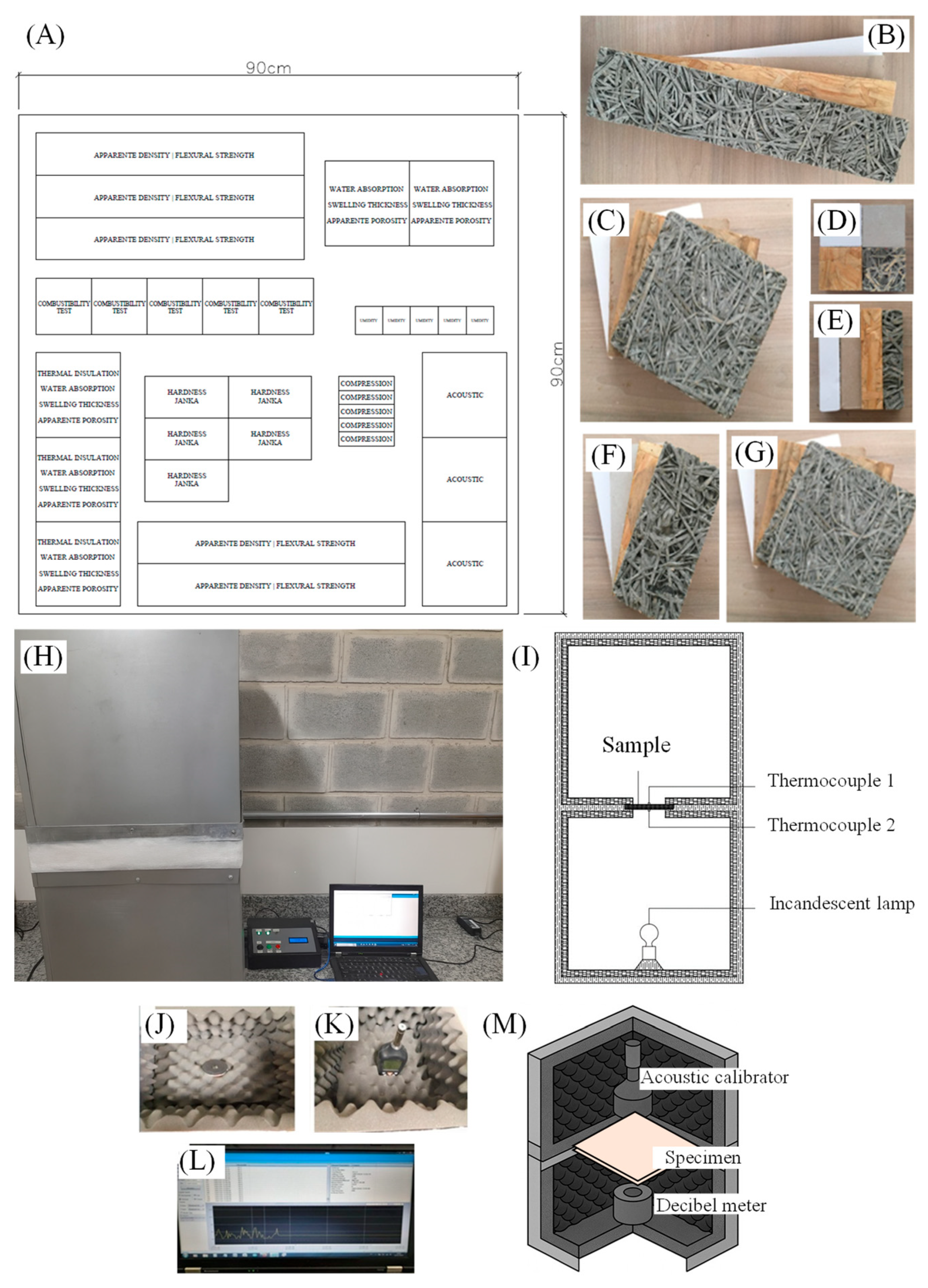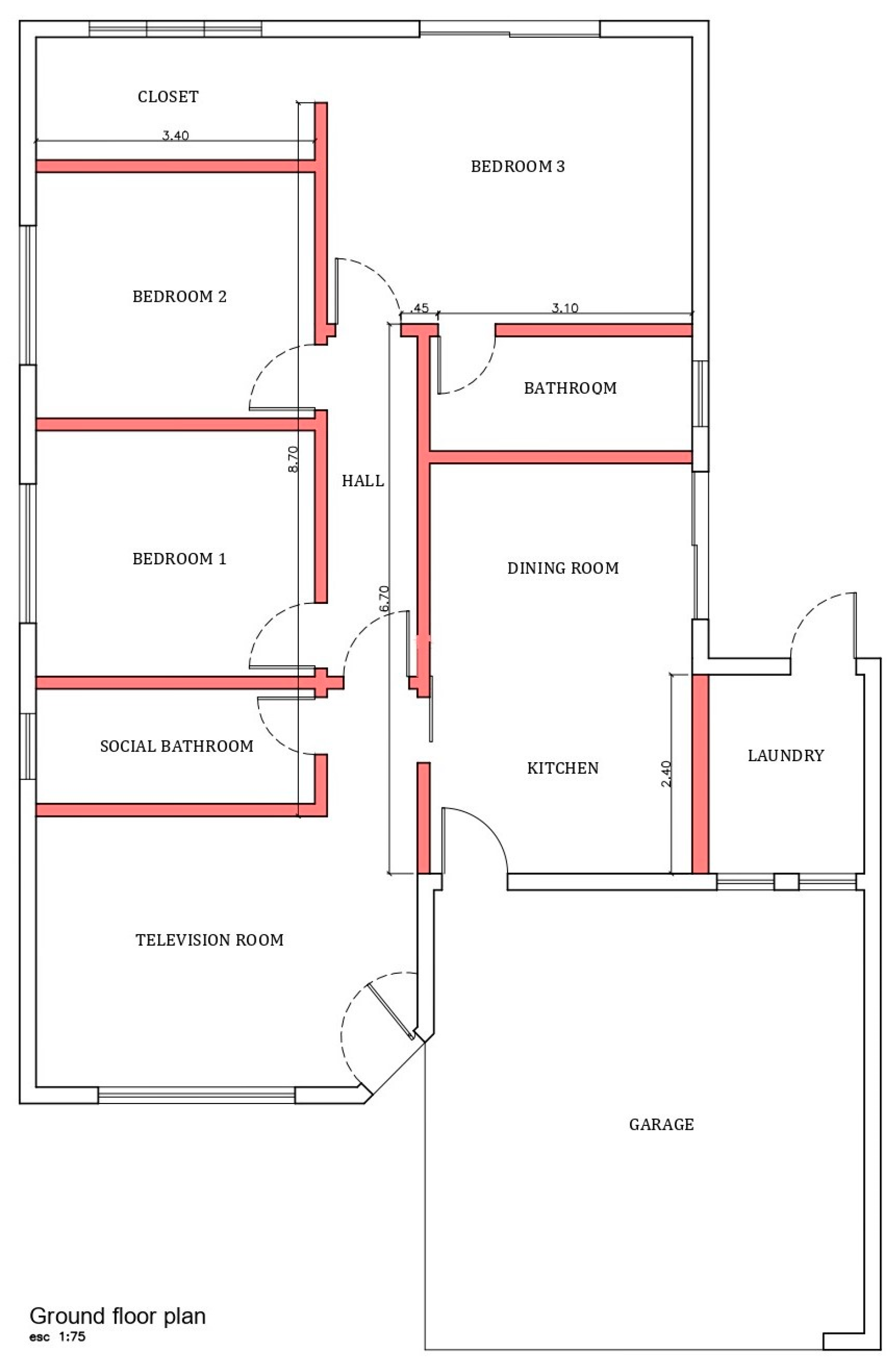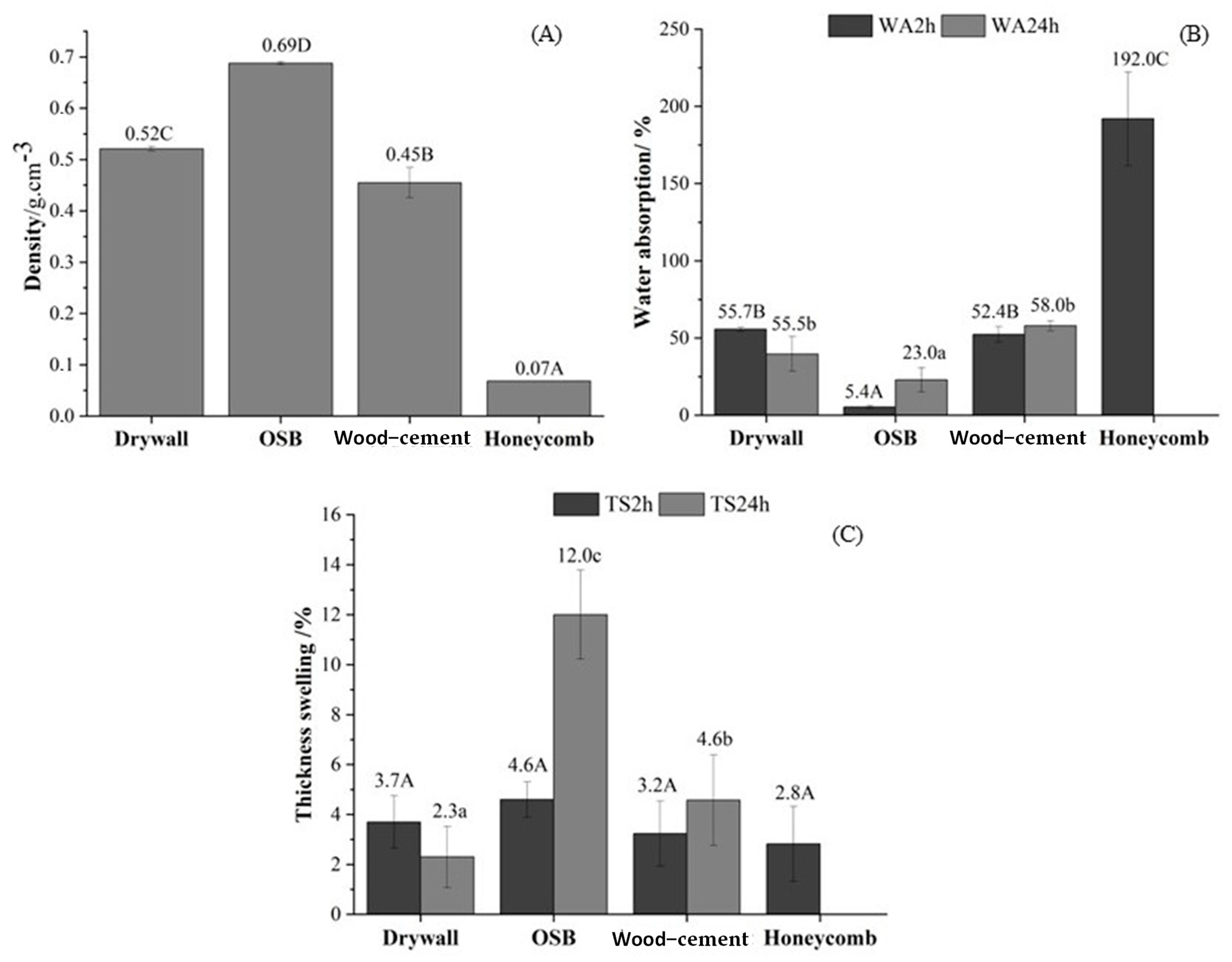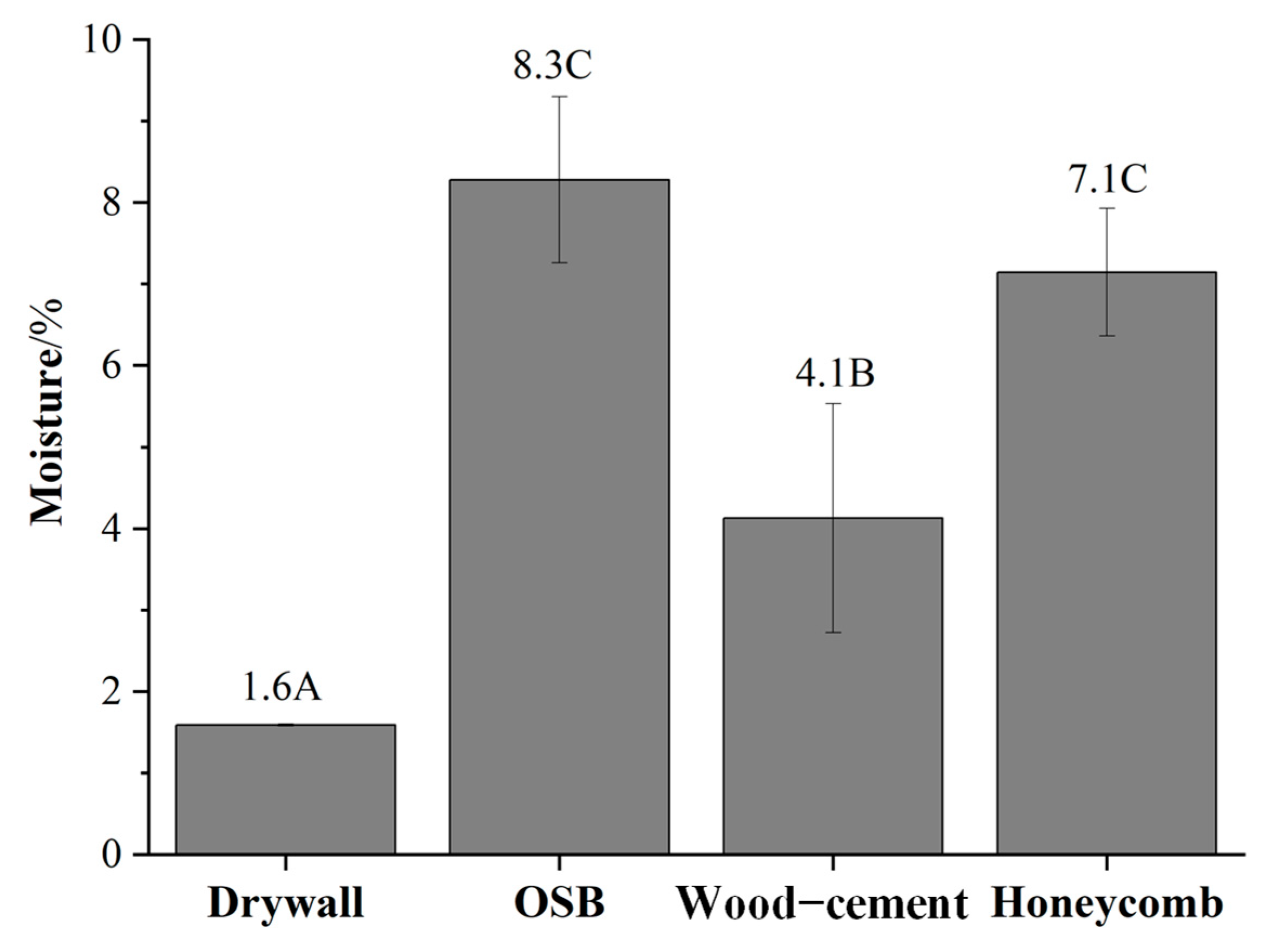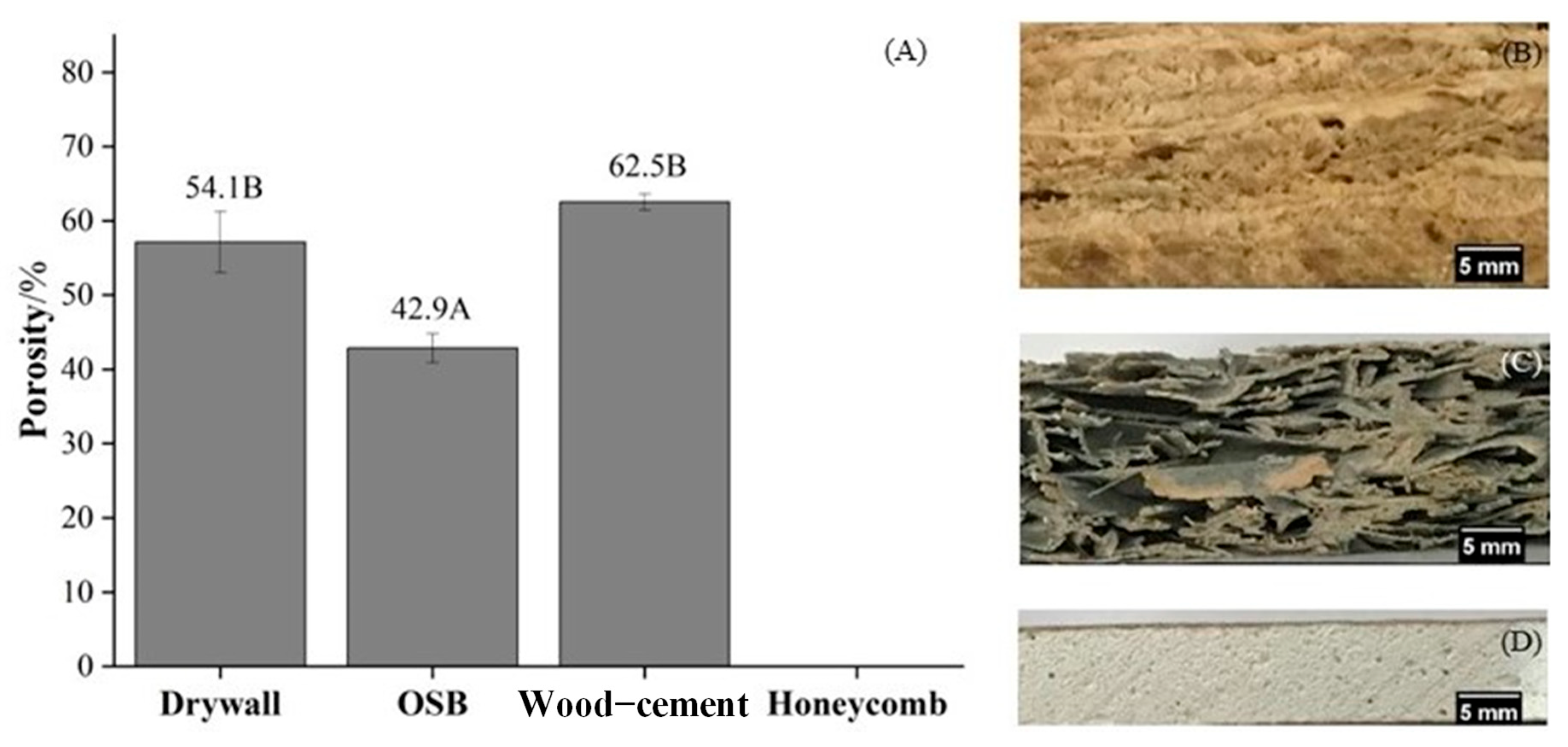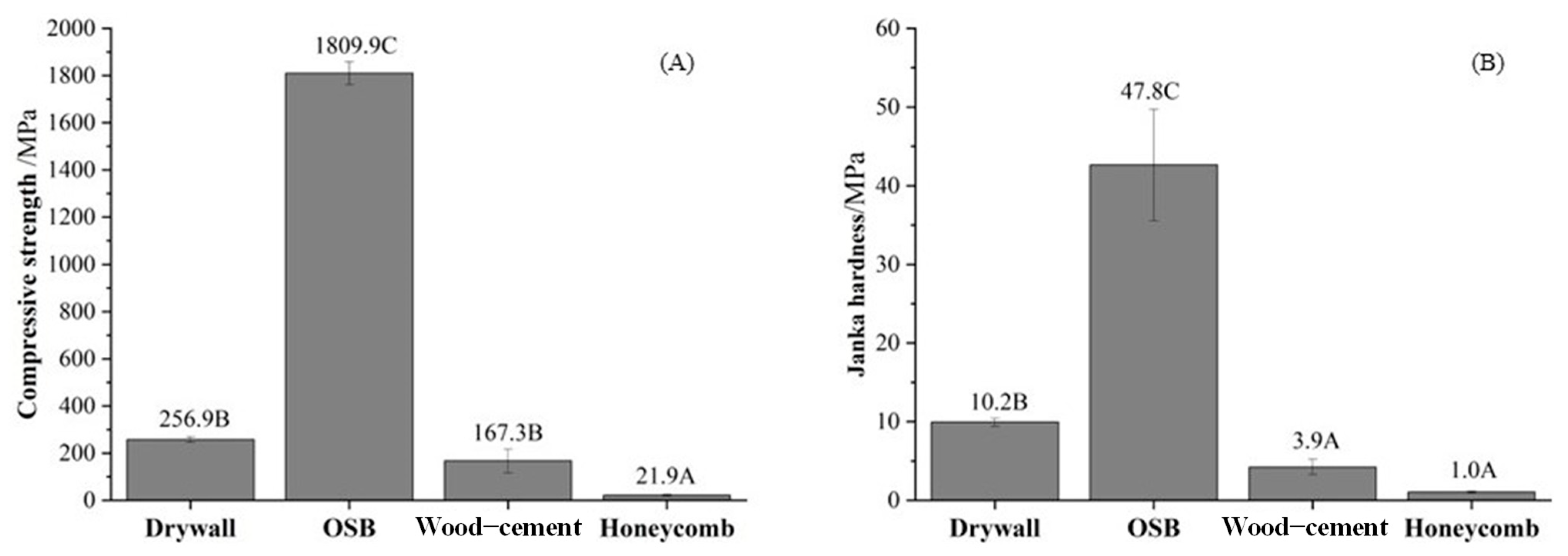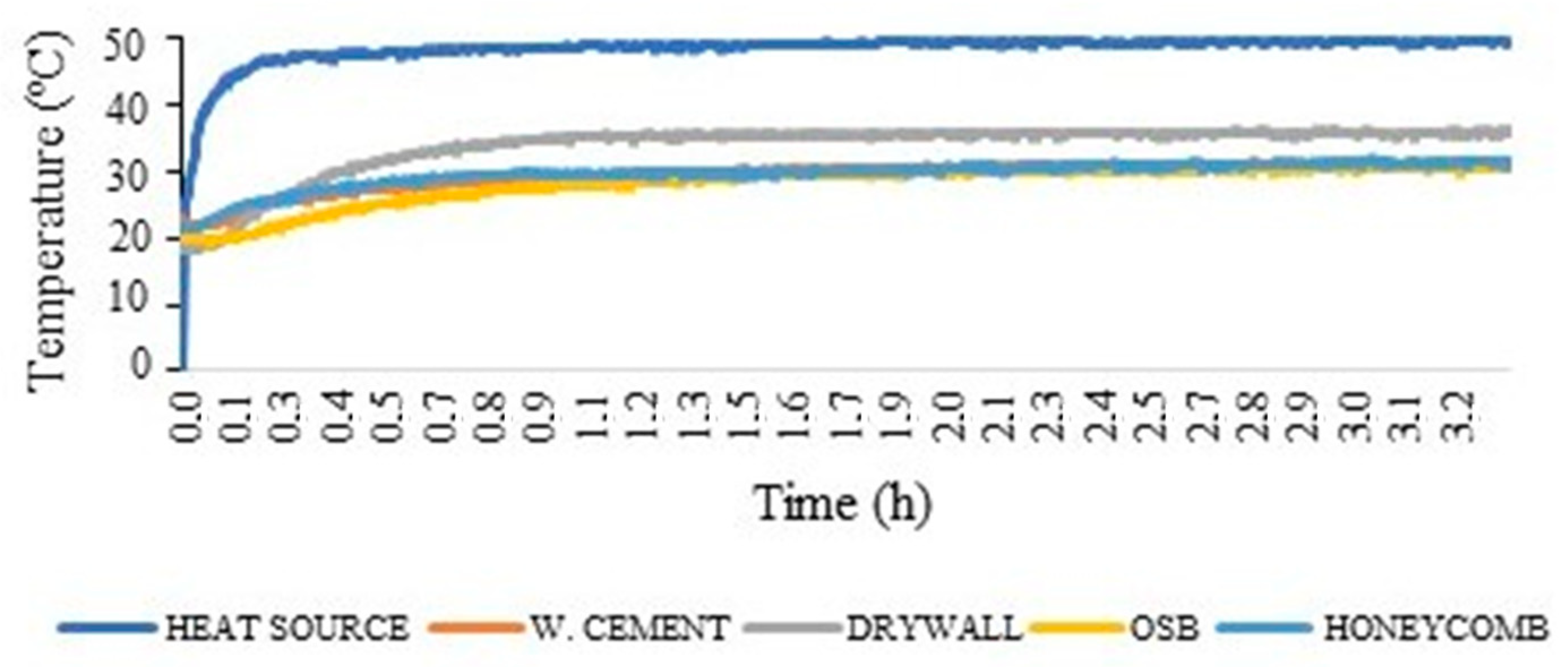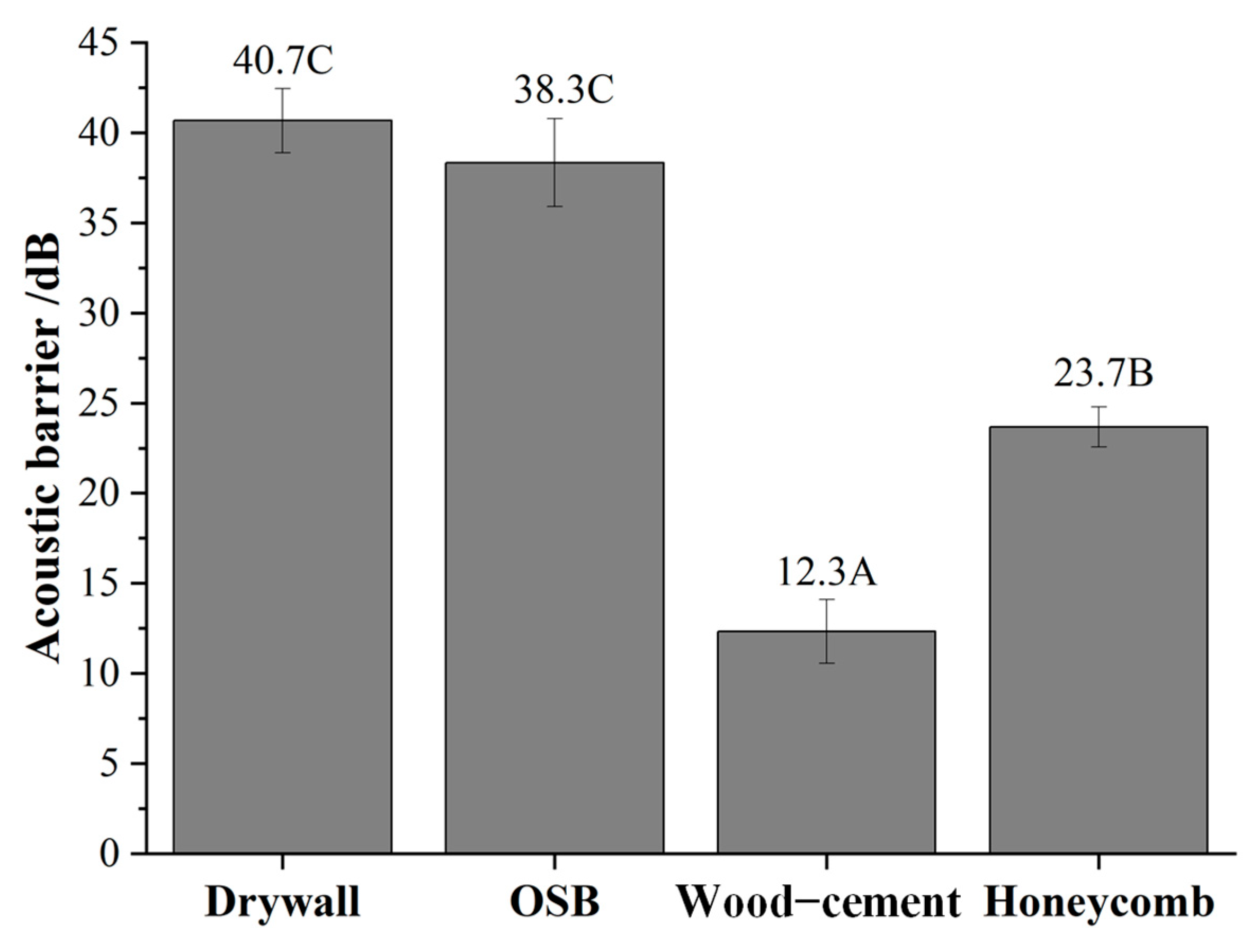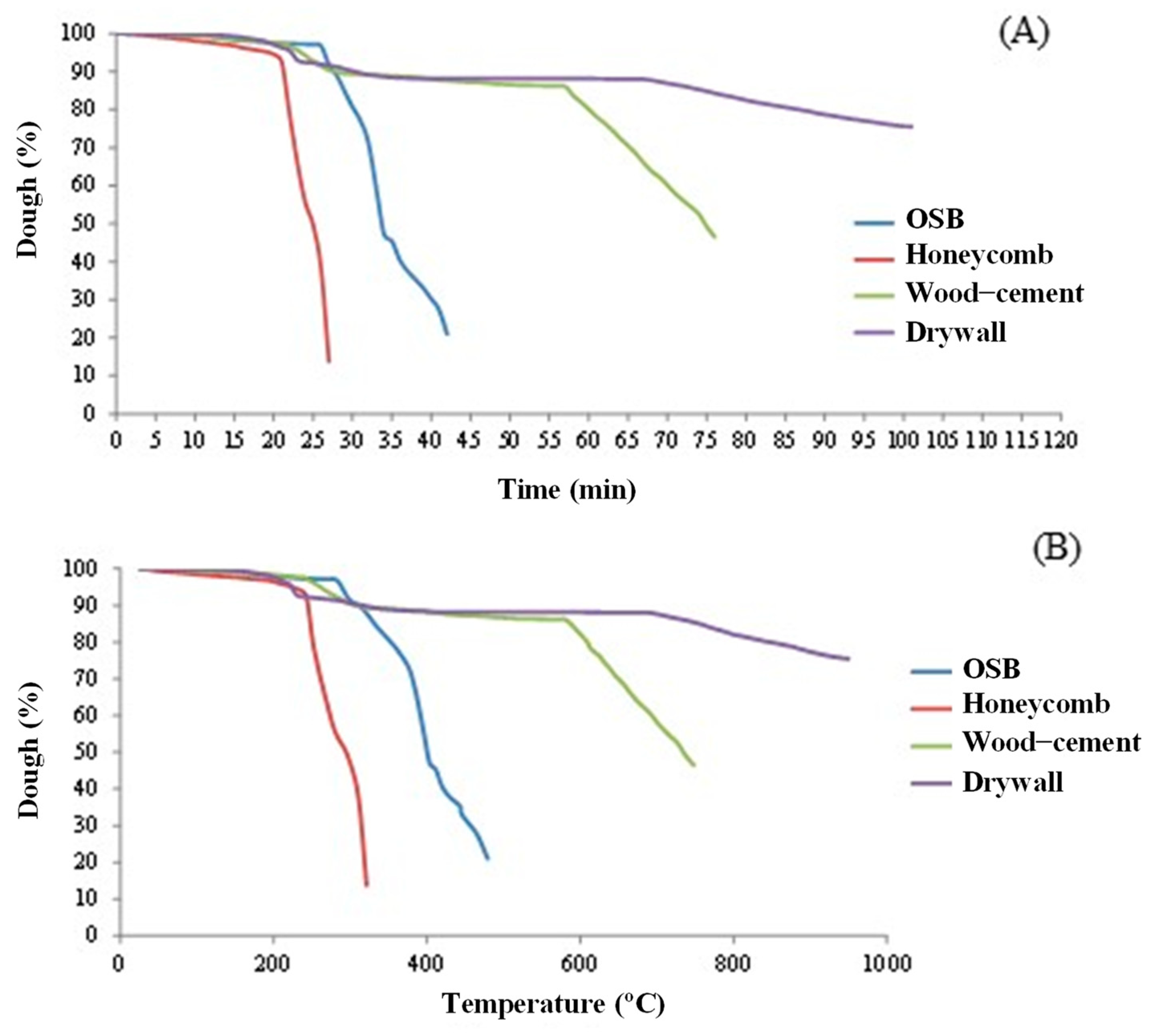1. Introduction
The civil construction industry consumes many natural resources, and it is responsible for a quarter of the solid waste generated worldwide [
1,
2]. This level of solid waste generation may increase in developing countries such as Brazil, where waste generated by the construction industry accounts for over 60% of all solid waste generated [
3].
Given the large level of waste generation, which promotes serious environmental and public health problems [
4], awareness of environmental issues in the civil construction sector has increased [
5], thereby increasing the demand for the development of new and increasingly sustainable technologies. Scholars are aiming at developing efficient, clean technological solutions with new properties to improve consumer welfare. For example, recent studies have explored the incorporation of industrial by-products into building materials as a promising approach to reduce environmental impact [
6]. Moreover, the development of bio-based and recyclable composites for construction applications has gained considerable attention in the literature [
7,
8].
Modern construction methods involve the production of structures and their parts in factories, bringing multiple benefits, such as accelerated construction, relatively few defects, low energy consumption, and low waste production, reducing waste production in construction sites and eliminating certain safety risks [
6,
9,
10]. Among these products are panels for interior partitions, which have gained prominence due to the ease of assembly, the reduction in thickness, the gain in internal spaces, and the improvement in architectural flexibility; these advantages are associated with the possibility of improving the thermal insulation and acoustics characteristics.
Drywall-type panels are some of the most used interior partitions to date, and they have several suitable properties, such as installation ease, short installation time, good cost–benefit ratio, and good sound insulation [
11]. However, despite being in a previously defined market, they still have some difficulties, especially regarding thermal insulation, moisture resistance, and nonrenewable gypsum sourcing [
12,
13].
Thus, aiming at the continuous improvement in the properties of the panels for application as partitions and at increasingly making the construction industry sustainable, studies with different types of products are of paramount importance. Some studies with different panels, such as oriented strand board (OSB) panels, honeycomb panels, and wood–cement panels, have already been developed, demonstrating the potentially varied application of these materials, such as furniture making, internal coverings, external coverings, linings, door manufacturing, and partition manufacturing [
14,
15,
16,
17,
18,
19,
20]. Accordingly, this study investigated the performance of drywall, OSB, wood–cement, and honeycomb panels, which represent a spectrum of conventional and emerging technologies for a partition system. Drywall is a widely adopted material for interior partitions, while OSB and wood–cement panels offer more sustainable and durable alternatives and honeycomb panels present a lightweight solution with promising thermal and acoustic performance.
Hence, research on interior partition panels has progressively expanded, highlighting diverse materials and technologies. However, significant challenges remain in consolidating these findings to guide practical applications in the construction industry. Existing studies often focus on isolated material properties, which limits a holistic understanding necessary for real-world construction scenarios. There is a lack of comparative evaluations of alternative panels for interior partitions of buildings, considering a full set of physical, mechanical, thermal, acoustic, and economic performance indicators. In addition, the applicability of emerging or unconventional panels specifically for interior partition use remains underexplored. Without such comprehensive analysis, the construction sector risks slower adoption of sustainable alternatives and missed opportunities to reduce environmental impacts effectively. In this context, the present research is important to provide a clear foundation that supports the design, selection, and market acceptance of conventional and advanced partition materials, ultimately contributing to more sustainable building practices.
In response to these research gaps, this paper makes the following contributions. (i) It provides a comparative technical evaluation of four types of panels (drywall, OSB, wood–cement, and honeycomb panels) under standardized testing protocols, offering a holistic view of their strengths and limitations; (ii) it introduces an integrated methodology that combines mechanical, thermal, acoustic, combustibility, microstructural, and cost analyses to inform both technical and market decisions; and (iii) it delivers practical recommendations for the selection of sustainable interior partition materials, supporting the transition to sustainable practices, improving the understanding of these products and expanding their market options.
2. Materials and Methods
A standard drywall panel provided by a company in Oliveira/MG was used in this study. The drywall panel had dimensions of 1.80 m × 1.20 m × 15 mm, with sides consisting of 1 mm thick cardboard sheets and gypsum crumb. The OSB panel was purchased from a company in Pouso Alegre/MG. The panel had dimensions of 1.20 m × 2.40 m × 18 mm, consisted of strand-type Pinus wood particles, and was joined in a hot press with phenol formaldehyde resin. The wood–cement panel was purchased from a company in Blumenau/SC, with dimensions of 0.90 m × 0.90 m × 17 mm; the panel consisted of Portland cement CPV-ARI and fine and long particles of Pinus sp. wood. The honeycomb sandwich panel was purchased from a company in Diadema/SP, with dimensions of 1.20 m × 2.40 m × 16 mm. The panel consisted of fully recycled material, with the core consisting of 0.04 m × 0.03 m cardboard alveoli and the sides consisting of heavyweight Kraft paper covered with a plastic layer and bonded with polyvinyl acetate (PVA) glue. The thicknesses of the panels are differentiated due to the specificities of the production and commercialization standards of each panel type.
The samples were cut into specific sizes and stored under the same climatic conditions. In the present work, experimental tests were carried out to evaluate the following properties of the panels: bulk density, water absorption, thickness swelling, moisture content, apparent porosity, modulus of rupture, modulus of elasticity, compressive strength, Janka hardness, thermal conductivity, thermal resistance, thermal transmittance, sound barrier, combustibility, microstructure, and cost. However, it is important to highlight that previous research [
14,
15,
16,
17,
18,
19,
20] has employed experimental tests beyond those used in the present study, focusing on different materials and performance aspects, such as impact resistance, seismic behavior, durability in saline environments, frequency-dependent sound transmission, creep behavior, etc.
2.1. Physical and Mechanical Tests
For the physical characterization of the panels, tests of bulk density, water absorption after two and twenty-four hours of immersion (WA2h and WA24h), and thickness swelling after two and twenty-four hours of immersion in water (TS2h and TS24h) were performed. Furthermore, tests were performed concerning the moisture and apparent porosity. For mechanical characterization, modulus of rupture (MOR) and modulus of elasticity (MOE) tests were performed to investigate the static bending, compression, and Janka hardness, according to the standards, quantities, and dimensions of the specimens highlighted in
Table 1.
For the mechanical characterization of the panels, an Instron Universal Testing Machine with a 6-kN load cell was used. For the bending test, a configuration of three cleavers, a test speed of 5 mm/min and a span of 38 cm was used. For the compression test, a test speed of 5 mm/min was used.
Figure 1A shows the sampling distribution and
Figure 1B–G show the specimens corresponding to the four types of panels evaluated for use as interior partitions. These specimens were used in the physical, mechanical, thermal, and acoustic tests conducted throughout the study.
2.2. Thermal Performance
The thermal conductivity was determined using equipment adapted from the fractional column method described by Bertolini [
22], in which two samples were used for each panel. The panels had dimensions of 15.2 cm × 15.2 cm, with thicknesses depending on each panel type. The chamber used in the test was composed of reconstituted wood panels. For sealing, 15 mm Styrofoam plates were used with an aluminized blanket composed of five layers (aluminum/polyethylene/reinforcement/polyethylene/aluminum), with 90% reflection and aluminum adhesive tape [
23,
24]. A 60 W incandescent lamp with controllable temperature was used to heat the equipment (
Figure 1).
The thermal conductivity was calculated when the system reached a steady state of heat conduction, where the temperatures were recorded by thermocouples through data collector equipment of the model IM DC 100-01E.
The specimens were tested separately, and the material was exposed to room temperature at a heating rate of 1 °C/min until a temperature of 50 °C was reached in the heat source. The test cycle for each treatment was 3.5 h. The test involved thermocouples, and it provided the temperatures at the base of the standard (incandescent lamp) and the temperatures at the base and top of the specimen (°C). Through this test, it was possible to determine the insulation, conductivity, resistance, and thermal transmittance values of each panel. The thermal insulation was obtained by the difference between thermocouple 2 and thermocouple 3 (
Figure 1), and the other properties were obtained using Equations (1)–(3).
Here, each element is represented as follows:
λ = thermal conductivity [W/(m. °C)];
270 = radiation of the lamp (W/m2), obtained by the Solar power meter MES-100;
E = panel thickness (m);
ΔT = change in panel temperature (°C);
RT = thermal resistance (m2. °C/W);
TT = thermal transmittance (W/m2. °C).
2.3. Acoustic Performance
The test to determine the sound barrier property was performed according to the proposal of an alternative method based on the different existing standards, such as the Brazilian Standard (NBR) 15575 [
25], International Organization for Standardization (ISO) 717 [
26], and ISO 10847 [
27], addressing the performance characteristics of residential buildings, the classification of acoustic insulation in buildings, and the characteristics of external noise barriers, respectively.
This approach is aligned with the technical guidelines of BS 8233 [
28] (British Standard Guidance on Sound Insulation), which recommends the use of reference sound pressure levels, frequently set at 94 dB, for insulation assessments under controlled conditions as a practical basis for material comparison. According to BS 8233 [
28], sound pressure levels ranging from 40 dB to 94 dB are routinely applied to evaluate the acoustic insulation performance in indoor environments. This reinforces the applicability of the chosen methodology to compare the acoustic barrier efficiency of the different types of partitions investigated in this study.
Comparative tests were performed using three samples of each panel, with dimensions of 15 cm × 15 cm and unique panel thicknesses. This method consisted of analyzing the noise attenuation from a board using two overlapping wooden boxes of medium-density fiber (MDF) lined internally with 15 mm Styrofoam boards and a 30 mm acoustic foam blanket. The panels were placed individually in an MDF partition with a central hole that had a diameter of 1.5 cm for the passage of noise, with a sound emission point (acoustic calibrator with a value of 94 decibels) placed in the upper box over 5 cm from the panel and with another sound capture point (decibel/sound pressure level meter) placed in the lower box and fitted into the hole in the partition, which was 1.0 cm from the specimen. Thus, the sound passed in a single direction with a passage time of 200 s. At the end of each test, the sound level meter was adapted to the computer to transcribe values and calculations. The first 60 s were excluded from the calculation to eliminate initial noise until the boxes were assembled and the test was initiated. This test made it possible to determine the acoustic barrier that each panel promoted by using Equation (4).
where each element is represented as follows:
2.4. Combustibility Test
The test to determine the combustibility was performed according to the proposal of an alternative method for comparing the heat performance characteristics in real and simulated fires. The test was based on different standards, such as NBR 10636 [
29], NBR 14432 [
30], and National Fire Protection Association (NFPA) 251 [
31], addressing the flame surface propagation in construction materials, the partition wall fire resistance without structural function, the building constructive element fire resistance, and the civil construction and material fire resistance, respectively.
For the combustibility test, an alternative device to those provided in the standards was developed, adapting a muffle furnace with a maximum temperature of 1200 °C, a semi analytical scale with a resolution of 0.01 g positioned on the muffle, and a thermocouple K-type front insertion with a temperature controller. Five samples were used for each panel, with dimensions of 10 cm × 10 cm and unique panel thicknesses, which were tested separately in a muffle furnace. Because the tested materials were different, the maximum temperature of each was considered until its undoing, ending after degradation. The heating rate was 10 °C.min−1. The time, temperature, and weight loss were measured every minute.
2.5. Microscopic Characterization
The panels were subjected to microscopy analyses using a CoolingTech digital magnifying glass, model U500X (CoolingTech Ltd., Overland Park, KS, USA), in which three samples were evaluated for each panel. The panels had dimensions of 5 cm × 5 cm with unique thicknesses. This characterization was performed on the surfaces of the panels to observe the distributions of the particles, the interfaces of the layers, and the porosities of the materials.
2.6. Cost Analysis
For the cost analysis, the market values of each panel were used. The data were obtained at the time of acquisition. A simulation of the construction of a 100.00 m
2 single-story house with a ceiling height of 2.80 m was performed. The interior partitions amounted to 103.46 m
2 (
Figure 2). This case scenario was used to evaluate the cost to build the internal walls with each panel when constructing a basic affordable house.
2.7. Statistical Analysis
The parameters evaluated in this research were subjected to statistical analyses, based on a completely randomized design (CRD). These analyses were performed using the statistical analysis software Sisvar [
32]. The results were evaluated by analysis of variance (ANOVA) and the Scott–Knott test, using a significance level of 5%. Before applying the ANOVA, the homogeneity of variance was assessed using the Levene’s test, while the normality of the residuals was evaluated through the Shapiro–Wilk test, as recommended by standard procedures in the scientific literature [
33,
34].
3. Results and Discussions
3.1. Apparent Density
Figure 3A shows the mean values of the bulk densities of the drywall, OSB, wood–cement, and honeycomb panels. All panels differ statistically from each other, with the lowest value being obtained for the honeycomb-type panels and the highest value being obtained for the OSB panels. The honeycomb panels have much lower densities than the other panels. According to Jiloul et al. [
20], this phenomenon occurs due to the characteristics of the material; these panels are produced with open internal cores and adhered faces to provide the mechanical strength of the product, optimizing mechanical properties while allowing for a reduction in density.
The American Society for Testing and Materials (ASTM) D1037 standard [
21] defines low-density panels as those with densities lower than 0.59 g/cm
3 and medium-density panels as those with densities between 0.60 g/cm
3 and 0.80 g/cm
3. Thus, the OSB panels are classified as medium-density panels, while the other products are classified as low-density panels. The OSB panels have high densities because of the production method of each material. OSB panels have compression ratios between 1.3 and 1.6, thus promoting the densification of the material [
14,
16]. In the other products, the compaction is not as pronounced as it is for drywall and honeycomb panels, which present the gluing of panel faces with the crumb that compose them. Despite having a certain densification, the wood–cement panels have many voids due to the geometry of the particles used in the production process [
18].
The density of the panel significantly affects the physical, mechanical, acoustic, and thermal properties of the construction materials [
20,
35,
36,
37]. Consequently, the apparent density affects not only the material’s structural stability and sound insulation but also its ease of handling and installation, since denser partitions tend to offer better acoustic performance and durability but can increase the weight load on supporting structures.
Zhuang et al. [
38] found that OSB panels with high-density wood species actually exhibited lower thickness swelling, suggesting that controlled densification can enhance stability. However, Kumagai et al. [
39] observed that rubberwood-based OSB panels, despite their density being similar to plywood, showed significantly higher thickness swelling, reaffirming that densification may compromise dimensional stability. According to Iwakiri et al. [
40], high-density panels have high rupture and elastic modulus values, and low-density panels have high porosities. However, certain materials may have better thermal and acoustic insulation characteristics. Jiloul et al. [
20] reported that sandwich panels, which are composed of at least two materials with complementary properties, outer layers, and a core, are low-density panels with great porosities. According to the shapes that the outer layer and the joint system are processed to resemble, the panel can offer structural improvement.
3.2. Water Absorption
The average values obtained for the water absorption of the different panels after two hours (WA2h) and twenty-four hours (WA24h) can be seen in
Figure 3B, except for the WA24h value of the honeycomb panels, which was not measured due to their hygroscopic characteristics. No significant difference is apparent between the properties of WA2h and WA24h when the drywall and wood–cement panels are compared. The OSB and honeycomb panels differ statistically from each other and from other panels. The OSB panels show the lowest water absorption values, which is associated with higher density (
Figure 3A,B) and greater compaction levels than other products [
14,
41,
42]. Zhuang et al. [
38] reports that the low values of water absorption of the dense panels occur due to the relatively closed structure of the panel, which is a consequence of the particles being further densified by pressing. This phenomenon is affected by the chemical products used in its production, such as the use of paraffin, which degrades the water absorption characteristics of the panels, especially in the first hours of contact with water [
43,
44].
Although the wood–cement panels show compaction levels that are similar to those of the OSB panels and still rely on the cement coating of wood particles, they show intermediate water absorption values. This phenomenon is explained by the association of cement with wood particles, which affects the cement hydration process [
19,
45] and the porosity of the composite, thus reducing the density (
Figure 3A,B) and increasing the water absorption values.
Although drywall has a density higher than that of wood–cement and does not have sufficient particles to provide porosity, the effect of water absorption is the same; this phenomenon is clearly affected by the cardboard faces, which are materials that promote great absorption of water due to their hydrophilic nature [
46]. The same justification can be provided for the honeycomb panels due to their cardboard-based composition, promoting new sorption sites for water. In addition, because of this high absorption, it is not possible to perform the WA24h analysis of the honeycomb panels; there is a complete rupture of the glue between the crumb and the faces, as shown in
Figure 4A. These results demonstrate that, in addition to possible adjustments in the manufacturing process, such as the use of adhesives with greater moisture resistance or the application of hydrophobic treatments to the paper faces, the hydrophilic nature of the raw materials used imposes inherent limitations on the application of honeycomb panels in humid environments.
There are no standards for the water absorption properties of OSB, wood–cement, and honeycomb panels. For drywall, the standard NBR 14715 [
47] shows a maximum value of 5% for moisture-resistant panels, demonstrating that the panel evaluated in this study cannot be considered moisture-resistant. However, the standard NBR 15575-4 [
25], which defines the requirements for residential buildings and their internal and external vertical sealing systems, does not specify maximum water absorption values for materials applied in interior partitions.
Carvalho et al. [
48], when evaluating different types of adhesives to produce particleboard, obtained WA2h values between 77 and 103% and WA24h values between 89 and 131%. When evaluating the thermal treatment of strand particles to produce OSB panels, Mendes et al. [
14] obtained WA2h values between 21.7 and 38.0% and WA24h values between 34.0 and 42.0%. When evaluating the use of tire rubber to produce wood–cement panels, Vilela et al. [
18] obtained WA2h values between 25.8 and 28.3% and WA24h values between 28.6 and 32.0%. When evaluating the manufacturing of wood–cement panels with partial replacement of cement by wood ash, Vu et al. [
49] found that the values of WA2h and WA24h increase progressively with replacement, ranging from 39% to 76.9% and from 42.7% to 76.1%, respectively.
In general, the OSB panels evaluated in this study show lower water absorption values than those found in the literature. The wood–cement panels show water absorption values within the range of values reported in the literature.
3.3. Thickness Swelling
The average values of panel thickness swelling after two hours (TS2h) and after twenty-four hours (TS24h) of immersion in water are represented in
Figure 3C, except for the TS24h value of the honeycomb panels, which was not measured due to their hygroscopic characteristics. There is no significant difference between the different panels for interior partitions when analyzing the TS2h property. For the TS24h, it is impossible to analyze the honeycomb panel for the same reasons reported for WA24h. However, when the wood–cement, OSB, and drywall panels are compared, a significant difference is observed between each, with the lowest value being obtained for the drywall panels and the highest value being obtained for the OSB panels.
The high mean value obtained for the TS24h of the OSB panels arises due to the release of stresses from the pressing because they are highly compacted, have relatively few pores, thereby preventing water absorption. However, these panels have relatively high stresses, maintained by the gluing of the material. Over time, this tension is released when the material is in contact with water for a long period, increasing the thicknesses of the OSB panels [
16,
50,
51]. Nevertheless, these panels meet the specifications of standard EN300 [
52] with a maximum value of 15% TS24h for panels used under wet conditions and 20% TS24h for panels used under dry conditions. Therefore, these OSB panels may be used in partitions in dry environments, such as bedrooms and living rooms, and in relatively humid environments, such as kitchens and bathrooms.
For the honeycomb panel, despite reaching a high water absorption level, it does not exhibit swelling in its proportional thickness due to the spaced conformation of its alveoli; thus, the water has some storage in the voids without providing variation in the thickness of the material.
The drywall panel presents a lower TS24h value than TS2h value due to material and adhesion losses of the cardboard faces with the gypsum crumb (
Figure 4B), consequently resulting in surface mass loss after immersion over time. This phenomenon occurs due to the low water resistance of this type of material, as discussed in other studies [
53,
54,
55].
There are no regulations for the thickness swelling of honeycomb and dry wall panels. The Viroc standard [
56] can be used to find the swelling value at the maximum thickness of the wood–cement panels after 24 h of immersion (1.5%). The Bison process [
57] can be used to find other maximum values: 1% for the TS2h and 1.5% for the TS24h. Therefore, this panel, despite being commercial, does not meet the minimum requirements for commercialization. However, the standard NBR 15575-4 [
25] which presents the requirements for residential buildings and their internal and external vertical sealing systems, does not specify swelling values in the thickness of the materials. Thus, the four types of panels can be used for interior partitions in dry environments, such as bedrooms and living rooms; however, in humid environments, such as kitchens and bathrooms, applications of honeycomb, drywall, and wood–cement are not indicated.
3.4. Moisture
Figure 5 shows the average moisture values of the different panels evaluated for application as partitions. No significant difference is observed between the OSB and honeycomb panels, which are the materials that obtain the highest moisture values. The lowest value is obtained for the drywall panels, while the wood–cement panels obtain intermediate values.
The humidity levels of the panels are associated with the chemical compositions of the raw materials that constitute them and with the types of additives used for their production, which affect the final qualities of the panels, especially those composed of wood or wood derivatives [
58]. Moisture absorption/adsorption of lignocellulosic materials occurs through OH-type hygroscopic sites available mainly in the amorphous region of cellulose and hemicellulose [
59]. Therefore, the greater the amount of lignocellulosic material is, the greater the number of hygroscopic sites and, consequently, the greater the tendency for moisture to increase.
The panels with the highest amount of lignocellulosic material have the highest moisture values (OSB and honeycomb panels), followed by wood–cement panels, in which the cement covering the wood reduces the potential for the moisture absorption of the lignocellulosic material, and the drywall panels, which have their sides boarded and mostly consist of ceramic material.
The standards EN300 [
52], NBR 14715 [
47], and NBR 15575-4 [
25], which specify the requirements for OSB panels, drywall panels, and vertical sealing systems, respectively, do not determine values for panel humidity. The honeycomb panels do not have regulations regarding their requirements. For wood–cement panels, the Viroc standard [
56] can evaluate moisture values between 9 and 12%. The moisture value obtained for the wood–cement panel in this study is lower than that specified by the standard.
The company that manufactures OSB panels in Brazil, LP Building Products, states that the average humidity of this type of panel is in the range of 5 to 11% [
60]. When evaluating the effects of the thermal treatment on OSB panels, Mendes et al. [
14] obtained moisture values ranging from 6.0 to 8.8%. The values obtained in this study are within the moisture range of the OSB panels in the literature.
When evaluating different models of moisture transfer in construction systems, Woods and Winkler [
61] observed moisture values for drywall ranging from 1 to 5%. Thus, the values obtained in this study are within the range observed by these authors.
3.5. Apparent Porosity
In
Figure 6A, it is possible to observe the average apparent porosities of the different panels evaluated for use as interior partitions. As reported for the properties of water absorption and swelling in thickness, it is not possible to evaluate the porosities of the honeycomb panels due to them falling apart after a few hours of immersion in water. The OSB panels differ statistically from the other panels, obtaining the lowest average porosity value. There is no significant difference between the drywall and wood–cement panels.
The OSB panel has a low porosity due to its high compaction rate [
39], promoting the reduction in internal spaces, as observed in
Figure 6B; this characteristic is associated with the high density (
Figure 3A) and low water absorption of the material (
Figure 3B).
Although there is great variability in the physical structures of the wood–cement and drywall panels (
Figure 6C,D), the two panels obtain statistically equal porosity values, which can be explained by the fact that the drywall panels have many micropores in the structure, while the wood–cement panels show many macropores. Because the cement coating occurs on the wood particles, the porosities of the particles are not measured. Another issue is the period of analysis because after being in contact with water for a certain period, the drywall panels begin to lose mass (
Figure 6D), generating new pores.
3.6. Flexural Strength
The average values obtained for the MOR and MOE after bending the panels are evaluated for interior partitions, as observed in
Figure 7. The OSB panels obtain the highest average values of MOR and MOE, which are significantly different from the other panels. There is no significant difference between the drywall, wood–cement, and honeycomb panels when the MOR property is evaluated. However, for the MOE property, a significant difference is observed between the three types of panels, with the highest MOE values arising for the drywall panels and the lowest MOE values arising for the honeycomb panels.
The higher MOR and MOE values obtained by the OSB panels are related to the high densities (
Figure 3A) and low porosities (
Figure 6A) of the panels, which are provided by the great compaction in the production process. For the MOE, a direct relationship with density can be observed for all panels, and the same statistical differentiation for density (
Figure 3A) is observed (
Figure 7B).
Surdi et al. [
42] and Oliveira et al. [
62] found that the higher the density of the panel is, the higher the static bending resistance, which is justified by the compaction of the material and the amount of material to undergo rupture by tension at the bottom of the surface.
The standard NBR 14715 [
47] can be used to evaluate the minimum value for the MOR for drywall panels (2 MPa). The EN300 standard [
52] can be used to find the minimum values—10 MPa for MOR and 3500 MPa for MOE—for OSB panels used under dry or humid conditions. For wood–cement panels, the Viroc standard [
56] determines the minimum values of 9 MPa for MOR and 4500 MPa for MOE, while the Bison process [
57] determines the minimum values of 9 MPa for MOR and 3000 MPa for MOE. There is no standard for honeycomb panels. Therefore, only the OSB panels meet the specifications of their respective commercialization regulations and can be used in both dry and humid environments.
However, the standard NBR 15575-4 [
25], which specifies the requirements for vertical fencing systems, cannot evaluate the minimum values of MOR and MOE. Additionally, the other panels can be used as partitions if they meet the requirements of the properties that can be determined by this regulation.
3.7. Compressive Strength and Janka Hardness
Figure 8 shows the average values obtained for the compressive strength and Janka hardness of the different panels evaluated for interior partitions. For both properties, the OSB panels obtained the highest average values, differing statistically from the others. This fact is explained by the relatively high density (
Figure 3A) and low porosity (
Figure 6A) resulting from good compaction of the particles [
36,
42,
51,
62,
63], as previously discussed for MOR and MOE.
No significant difference is observed for the drywall and wood–cement panels when the compression is evaluated. However, the honeycomb panels obtain the lowest average compressive strengths, showing significant differences relative to the other panels. The low compressive strengths of the honeycomb panels are associated with their low densities (
Figure 3A) and physical structures, where there is a honeycomb core with voids and faces glued to its surface. Since there is no locking in the direction parallel to the honeycomb faces, the compression test led to much lower strength values.
The standards NBR 14715 [
47], EN300 [
52] and Viroc [
56] cannot determine the minimum values of compressive strength for the drywall, OSB, and wood–cement panels, respectively; likewise, there is no standard for honeycomb panels. However, the Bison process [
57] determines the minimum value (15 MPa) for the wood–cement panels and the standard NBR 15575-4 [
25], which specifies the requirements for vertical sealing systems, determines the minimum value of compressive strength (18 MPa). Thus, honeycomb-type panels are not suitable for use as interior partitions.
Appropriate compression values are necessary for the proper seating and stabilization of window frames. Although these types of interior partitions are not designed to withstand slab or roof loads, such partitions can be used as windows, and adequate values of compression are required for the adequate stabilization and settlement of the frames and window.
Nevertheless, the drywall panels have intermediate Janka hardness values, statistically differing from the wood–cement and honeycomb panels. There is no significant difference between the wood–cement panels and the honeycomb panels. The lowest values obtained for the honeycomb and wood–cement panels are associated with the physical structures of these products (
Figure 9), where large voids are observed in the center of the honeycomb panel (
Figure 9A). Concerning the faces of the wood–cement panels, there are macropores on their surfaces that reduce the resistance of this product to the penetration of the sphere (
Figure 9B).
The standards NBR 14715 [
47], EN300 [
52], Viroc [
56], Bison process [
57], and standard NBR 15575-4 [
25] cannot determine the minimum values of resistance to the Janka hardness for drywall, OSB, wood–cement and interior partition panels, respectively. Likewise, there is no standard for honeycomb panels.
The Janka hardness provides resistance to penetration by other bodies and is a very important characteristic that should be evaluated in panels with applicability in partitions because they need sufficient hardness to handle the general placement of pictures, mirrors, furniture, and decorations. In this context, the OSB panels show the best results.
3.8. Thermal Comfort
Figure 10 shows a graph of the differences in the panel temperatures recorded during the thermal conductivity test relative to the heat source.
Table 2 presents the temperature variation, thermal conductivity, thermal resistance, and thermal transmittance values for each panel regarding its applicability as an interior partition.
When evaluating the different panels for interior partitions, the wood–cement, OSB, and honeycomb panels obtain statistical equality and differ from the drywall panels, obtaining the highest values of temperature variation and demonstrating great thermal insulation potential [
53,
54,
64].
When the thermal conductivity is evaluated, the OSB panels have the lowest average values, statistically differing from the other panels. The wood–cement and honeycomb panels obtain statistical equality and differ significantly from the dry wall panels, obtaining relatively low values of thermal conductivity. Although the OSB panels have high density values (
Figure 3A) and low porosity values (
Figure 6A), affecting the thermal conductivities of these materials [
12,
13], it is verified that these factors do not guarantee that this panel is the best for thermal insulation, which is pronouncedly influenced by the type of material applied. Kyriakidis et al. [
12] observed the effect of the type of material on the thermal conductivities of walls, with lower values being obtained for walls produced with wood derivatives (0.14 W/(m. °C)) than for walls produced with dry wall plates (0.25 W/(m. °C)).
Therefore, the main reason for the reduction in thermal conductivity in panels produced with wood or with wood derivatives in greater quantity (OSB, wood–cement, and honeycomb) is due to the intrinsic characteristics of each material that constitutes them, such as the microporosity in the anatomical structure of wood, and also the conductivity of wood material (0.14 to 0.18) in relation to plaster (0.40 to 0.60) [
65]. This fact also explains the reduction in thermal conductivity in drywall panels compared to plaster only, given the inclusion of cardboard on the surface of these panels. In the case of honeycomb panels, the effect, in addition to the facing material being derived from wood, is also associated with the fact that air pockets are provided by the honeycomb format.
As for the properties of thermal resistance and thermal transmittance, it is observed that the OSB, wood–cement, and honeycomb panels obtained statistical equality and statistically differed from the drywall panels for both properties. It was observed that the alternative panels, evaluated for replacing drywall as interior partitions, obtained the highest values of thermal resistivity and, consequently, the lowest values of thermal transmittance.
The reduction in thermal conductivity and thermal transmittance values and the increase in thermal resistivity are considered excellent results for building materials, since the lower the conductivity and thermal transmittance, the lower the temperature exchange between the walls [
66], resulting in panels that are more suitable for residential or commercial applications that require an environment with greater thermal comfort and that aim to achieve lower energy expenditure for air conditioning [
67,
68].
3.9. Acoustic Isolation
The average values obtained for the acoustic barrier test of the different types of panels for interior partition can be seen in
Figure 11. The drywall and OSB panels obtained the highest average values of acoustic barrier, showing statistical equality and being statistically different from the wood–cement and honeycomb panels. A statistical difference was also observed when comparing wood–cement and honeycomb panels, with the highest average acoustic barrier values obtained for honeycomb panels.
Despite the OSB panels presenting the highest density values and the lowest porosity values, which help in the acoustic insulation of the product, it is observed that they obtained statistical equality with the drywall panels, already commonly used on an industrial scale and recognized for their good sound insulation [
69,
70]. This justification is due to the characteristics of wood in relation to plaster, in which lower acoustic insulation values are observed for wood than those obtained for plaster [
70,
71,
72], which is associated with the anatomical characteristics of the wood.
Wood–cement panels had the worst performance among the evaluated interior partitions, which can be explained by their more open physical structure (
Figure 6C and
Figure 9B), which promotes the direct passage of part of the emitted sound. Therefore, the use of wood–cement panels for interior partition with a more closed structure and greater density is indicated. Despite the honeycomb panels having air pockets inside, due to their production method, their composition in faces was not enough to provide a greater barrier to sound.
The NBR 14715 standard [
47] determines that drywall panels must have a minimum acoustic barrier of 35 to 37 dB. The Viroc standards [
56] and the Bison process [
57] specify values of 35 and 33 dB for cement–wood panels, respectively. The EN300 [
52] standard does not specify values for OSB panels and there is no regulation for honeycomb panels, while the NBR 15575-4 standard [
25] determines the minimum value of 30 dB for interior partitions. Therefore, only the drywall and OSB panels met their respective marketing standards and also the recommendations of the interior partition standard.
3.10. Combustibility Results
The average values obtained for the combustibility test of the different types of panels for interior partitions can be seen in
Figure 12. In
Figure 12A it is possible to observe the ratio of mass loss of the panels as a function of the combustion time, with a different behavior being verified for all types of panels evaluated. The beginning of the degradation of the honeycomb, OSB, wood–cement, and drywall panels was close to 30, 45, 80, and 105 min, respectively.
Figure 12B shows the loss of mass of the panels as a function of temperature, showing the beginning of their degradation at temperatures of 350 °C, 500 °C, 800 °C, and 1000 °C, for honeycomb, OSB, wood–cement, and drywall, respectively. The final mass loss of each type of panel was around 24% for drywall panels, 53% for wood–cement panels, 79% for OSB panels, and 86% for honeycomb panels.
In general, it was observed that the drywall panels had the highest temperature and the longest time to reach their final degradation, in addition to resulting in less final mass loss, being considered, therefore, as the panels with the greatest thermal stability and the most suitable for environments that present a higher risk of fire, as they would allow more time for adequate evacuation from the location.
Among the alternative panels evaluated for application as partitions, the wood–cement panels were the ones that obtained the best result, due to their greater resistance provided by the cement coating on the wood particles [
73]. The lowest resistance to thermal degradation was observed for the OSB and honeycomb panels, with greater emphasis on the honeycomb panels, which showed a lower degradation time and temperature, in addition to greater loss of final mass, which is due to their more open structure (
Figure 9A) and faces covered with cardboard materials, which causes a greater spread of flames.
The greater thermal decomposition of OSB and honeycomb panels are mainly justified by the thermal degradation of hemicelluloses and cellulose [
74,
75]. The lower thermal stability of carbohydrates present in lignocellulosic biomass is reported in the literature; that is, holocellulose (cellulose and hemicellulose) degrades at low temperatures [
76,
77]. The greater thermal decomposition of hemicelluloses is due to its amorphous, branched, and easily hydrolysable chemical structure [
78], while in cellulose, the greater effect occurs in the amorphous region. Generally, hemicelluloses are degraded between temperatures of 220 °C and 315 °C, cellulose between 275 °C and 350 °C, lignin between 150 °C and 900 °C, and extractives between 150 and 600 °C [
74,
76,
78]. Therefore, in a residential or commercial fire situation, the chemical composition of the panel consisting mostly of lignocellulosic material will affect its response in terms of its thermal stability and the time it takes to evacuate the site and propagate the fire.
3.11. Cost Analysis Results
The analysis of product costs per m
2 for each type of panel evaluated as an internal divider is shown in
Table 3.
In relation to drywall panels, which are currently the most used partition, it is observed that the use of wood–cement and honeycomb panels leaves the construction with the lowest cost, with reductions of 16.98 and 33.95%, respectively, while OSB panel dividers increase costs by 192.59%. Despite this, it is observed that the total amount spent on interior partitions for a standard house (
Figure 2) is very low in relation to the total cost of the construction, which can range from USD 366 to USD 1366/m
2 [
80], in addition to which, depending on the properties presented by the panels, the difference can be compensated over time, through a reduction in energy costs or by providing greater thermal comfort to the occupants of a house or commercial establishments. Therefore, the cost analysis must always be related to its cost-effectiveness, allowing the consumer to make a more adequate choice for his needs.
3.12. Summary of Results
Table 4,
Table 5 and
Table 6 present a summary of the main results obtained in this work, allowing for a direct comparison between the four types of interior partitions evaluated in this study. These tables provide a comparison of the average values of physical, mechanical, thermal, acoustic, and cost-related properties, facilitating the identification of performance differences among the tested systems.
It is noteworthy that the OSB panels demonstrated superior mechanical strength, as well as enhanced thermal and acoustic insulation properties, compared to the other panel types. However, they also correspond to the highest costs among the evaluated materials. In general, the wood–cement and honeycomb panels generally exhibited lower performance compared to the drywall panels, which are commonly used in interior partition applications.
4. Conclusions
Among the types of alternative materials evaluated as an option to replace drywall panels, OSB panels were the ones that obtained the best performance in terms of physical, mechanical, and thermal properties, and obtained acoustic performance similar to that of drywall panels. However, they obtained the lowest performance in terms of fire resistance and also the highest cost among the different types of interior partitions evaluated.
The drywall panels demonstrated adequate physical, mechanical, and acoustic properties for applications in partitions, also presenting the best performance in fires and better cost in relation to OSB panels. However, they showed the worst values for thermal insulation among the evaluated panels.
The wood–cement and honeycomb panels demonstrated that adjustments are still necessary in the production processes to allow adequate application as interior partitions. It is necessary to carry out analysis of other types of wood–cement and honeycomb panels.
The drywall and OSB panels met all the criteria determined by the NBR 15575-4 standard [
25] for applications such as sealing panels and can therefore be used for interior partitions in buildings. Thus, it is up to the consumer to decide which types of characteristics he wants for construction and to take into account the most appropriate cost–benefit ratio.
In conclusion, it is not feasible to designate a single material as the optimal choice for all applications, given that no material demonstrated superior performance across all evaluated criteria. However, it is noteworthy that the OSB panels demonstrated superior mechanical strength, as well as enhanced thermal and acoustic insulation properties compared to the other panel types. However, they also correspond to the highest costs among the evaluated materials. In contrast, while wood–cement and honeycomb panels generally exhibited lower performance, drywall panels offered a balanced combination of technical properties and cost-effectiveness, which explains their widespread use in interior partition applications.
Despite providing a comprehensive evaluation of the mechanical, physical, acoustic, combustibility, microstructural, and economic performance of alternative panels for interior partitions, this research was limited to experimental tests conducted under controlled conditions. Future studies are recommended to compare the long-term performance of these different types of panels under real environmental conditions, including the use of cone calorimetry tests. Based on the results of this paper, further research should also focus on developing design optimizations and investigating user-centered criteria, such as ease of installation and esthetic versatility, to further support the adoption of sustainable partition systems in construction.
